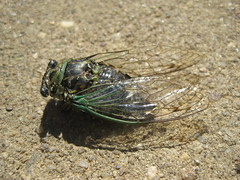No, not a locust, just an annual cicada. The annual cicada, to be distinguished from the periodic cicada (Magicicada) appears in the summer months (hence it's nickname, the "dog-day" cicada). The periodic cicada is even more amazing, appearing on a cycle of 13 or 17 years.
Here in Colonial Village we have lots of cicadas. One way you'll know they're around is by the ear-splitting sounds they make. The constant buzz can at times drown out the sounds of planes from nearby National Airport (DCA).
Because of the large number of trees in the Villages, we make a perfect home for the cicadas (generally cicadas are harmless to humans, pets and vegetation).
In the mid-Atlantic, we're home to the 17 year cycle cicadas (Magicicada cassini). Known as Brood X (or the Great Eastern Brood; Brood XIX, The Great Southern Brood is slated to appear in Maryland and Virginia in 2011, though the largest of the 13 year broods, it's not as common in Colonial Village), the last visit was in 2004, so we have a wait til they appear again. Well, actually they haven't left. They're under your feet! After the adults lay eggs, the young drop to the ground, burrow a few inches down, and stay there, waiting for whatever the signal is, seventeen years later for them to start the cycle over again.
FYI, some people do call the cicadas "locusts". Generally speaking locust refers to varieties of grasshoppers. However, when early settlers to the mid-Atlantic first came upon the cicadas, they were termed "locusts", hence the ongoing confusion.
Monday, September 21, 2009
Invasion of locusts?
Labels:
Around Colonial Village,
Insects
Location:
Colonial Village, Arlington, VA, USA
Subscribe to:
Post Comments (Atom)

![Reblog this post [with Zemanta]](http://img.zemanta.com/reblog_e.png?x-id=a649c469-e2dc-4458-a97c-30f5c111fcef)

No comments:
Post a Comment